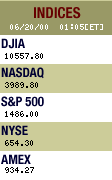| Corporate Financial Healthcare Technology | |
| Stock of the Day Tip of the Day Periscope | |
 for more information | |
|
Ecuadoreans struggle to make cents of switch to U.S. currency
But nearby shoppers here in Ecuador's capital were hardly
overjoyed trying to figure how much things cost amid the nation's
conversion to U.S. dollars from their local currency, the sucre.
"With the sucre being phased out, doing business has turned
into chaos,'' said Pedro Gutierrez, a merchant.
Currency confusion, for better or worse, is spreading as the
impoverished nation nears the Sept. 13 target for completing the
controversial switch from the sucre to the greenback.
Though recent opposition from Indians and labor groups is
fading, just figuring out the math of it -- $1 equals 25,000 sucres
-- is exasperating to many businesses and consumers.
More than two-thirds of people here earn less than $30 a month,
making the dollar appear disproportionate to the meager means of
the average Ecuadorean -- and unwieldy for most small purchases. A
$20 bill currently fetches 500,000 sucres.
President Gustavo Noboa hopes the changeover, which started in
March, will spur investment and bring down inflation topping 100
percent a year, the highest in Latin America.
In theory, the move to the dollar will dampen inflation by
preventing Ecuador's government from printing more money to meet
its budgetary needs after years of deficit spending.
Ecuador's Central Bank president, Jose Ycaza, reported in early
August that 79 percent of sucre bills and 14 percent of national
coins had already been pulled from circulation.
The introduction of U.S. currency -- including the temporary
introduction of U.S.-minted coins -- has spawned a boom market for
cardboard conversion charts, sold by street vendors for 1,000
sucres, or 4 cents.
Even with that tool as a crutch, figuring out a simple 70-cent
purchase has turned into a time-consuming mental workout for people
carrying both sucres and cents: two quarters, a dime, a 2,000-sucre
coin, and two pennies.
Distinguishing the value of the strange foreign coins from
sucres has turned into a daily preoccupation. Ecuador's Central
Bank plans to soon replace the U.S. coins with its own change, to
be minted in similar denominations, sizes and colors to U.S.
pennies, nickels, dimes, quarters and half dollars.
By phasing out its currency, Ecuador is joining Panama and nine
other countries in which the U.S. dollar is legal tender.
Opponents of the dollar plan contend it will only benefit the
rich and worsen conditions for the poor by driving consumer prices
up to international levels. Ecuador is cutting subsidies, mostly in
fuels, to meet conditions of international lenders involved in the
changeover.
Only two of every 10 Ecuadoreans have stable employment, and
higher fuel costs, it is feared, could lead to price increases
elsewhere in the economy.
But many analysts say it is too soon to judge the plan.
"To speak of failure is premature,'' said economist Francisco
Zalles. "We have only gotten to a point where a portion of
monetary resources are in dollars. Starting Sept. 13, we'll be able
to talk about a dollar economy.''
| ||
|
© , Fox Market Wire. All Rights Reserved Sitemap | Terms |